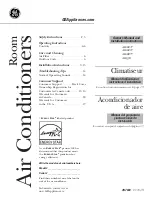
876572-BIM-C-0213
Johnson Controls Unitary Products
5
Unit Location
Several important factors must be considered before selecting
the site for this unit:
1.
Site – Select a solid level position, preferably on a concrete
slab, slightly above grade level and parallel to the home.
2.
Proximity to home or building – The length of the supply
and return ducts should be kept to a minimum with no
sharp bends. Consideration should be given to the
distance and routing of electrical service to connect the
unit. Try to select a site for the unit that it is as close as
possible to the proposed return grille location. Unit may be
positioned to draw air from underneath structure.
3.
Proximity to the clothes dryer vent – The clothes dryer vent
should not be located upwind from the unit.
4.
Ability to service – Side access panels of the unit should
not be closer than 24 inches to a structure so blower and
controls may be serviced.
5.
Sound transmission – Locate the unit away from bedroom
windows or other rooms where sound may be objectionable.
6.
Air Circulation – The outside coil sides should not be
closer than 24 inches to a structure that will restrict air flow
through the coil. The air discharge of the unit requires a 60-
inch clearance between the top of the unit and any
obstruction.See Figure 2.
7.
Wind direction – The hot condenser air must be discharged
up and away from the home or building, and if possible in a
direction with the prevailing wind.
8.
Relationship between building, sun and unit – If practical,
place the air conditioner in an area where the unit and the
ducts will be shaded from the afternoon sun (when the heat
load is the greatest).
9.
Defrost and Water Drainage - Water will run off the outdoor
coil when the heat pump defrosts during the heating
season. This water will run through the drain holes of the
heat pump base pan onto the ground below. A slight grade
away from the unit will improve drainage.
10. Average Winter Snow Depth - The heat pump must be
installed above the average snow depth to allow the
outdoor coil to drain properly.
Cinder blocks, if permitted by local codes, or a metal frame
may be used to support the unit above the snow. Insure
that the support does not obstruct drainage holes in the
base pan of the unit. Metal frame legs must be supported
by concrete pads. The heat pump must set level and
securely upon the support.
NOTE:
If installing on blocks, the middle rail must be supported.
Figure 2: Air Discharge Clearance
Site Preparation
After the site has been selected and prepared, using criteria
mentioned above, install the air conditioner support pad at the
selected site.
NOTE:
This unit must be installed and operated on a level
surface. Failure to do so will result in condensate
drainage problems.
60”






































